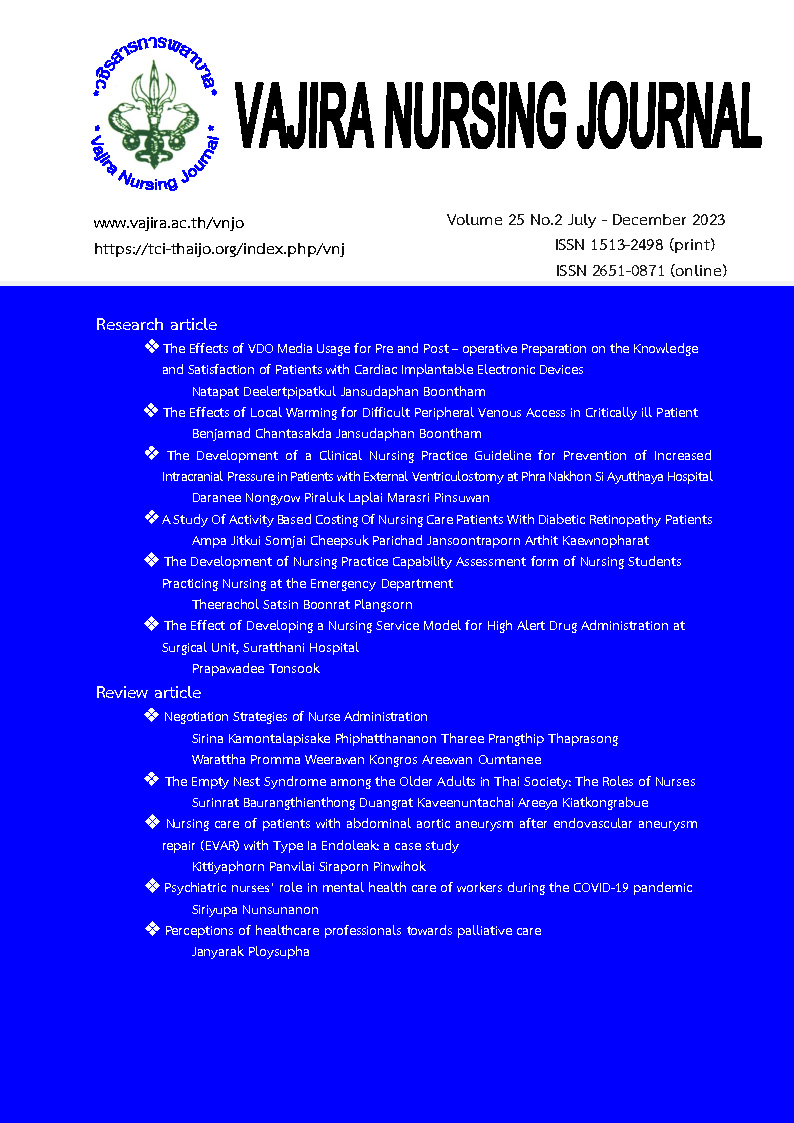การพยาบาลผู้ป่วยหลอดเลือดแดงใหญ่ในช่องท้องโป่งพอง หลังการผ่าตัดใส่หลอดเลือดเทียมผ่านสายสวน (endovascular aneurysm repair; EVAR) ที่มี Type Ia Endoleak: กรณีศึกษา
Main Article Content
บทคัดย่อ
โรคหลอดเลือดแดงใหญ่ในช่องท้องโป่งพอง เป็นโรคระบบหลอดเลือดที่พบได้บ่อยในสังคมเมือง ปัจจุบันนิยมรักษาด้วยการใส่หลอดเลือดเทียมชนิดหุ้มด้วยขดลวดผ่านทางหลอดเลือดแดงที่ขาหนีบทั้งสองข้างเข้าไปจนถึงหลอดเลือดแดงใหญ่ที่โป่งพองแล้วปล่อยให้ขดลวดถ่างขยายในช่องท้องที่เรียกกว่า endovascular aneurysm repair (EVAR) ซึ่งมีภาวะแทรกซ้อนที่พบได้บ่อยหลังการรักษาคือ endoleak ซึ่งภาวะนี้แบ่งได้หลายชนิดแต่ละชนิดมีวิธีการรักษาที่แตกต่างกัน บทความนี้จึงมีวัตถุประสงค์เพื่อวิเคราะห์ประเด็นปัญหาและบูรณาการบทบาทพยาบาลในการดูแลผู้ป่วยหลอดเลือดแดงช่องท้องโป่งพองหลังการผ่าตัดใส่หลอดเลือดเทียมผ่านสายสวนที่มี type Ia endoleak เพื่อให้ผู้ป่วยปลอดภัยและเกิดผลลัพธ์ทางการพยาบาลที่ดี
Article Details

อนุญาตภายใต้เงื่อนไข Creative Commons Attribution-NonCommercial-NoDerivatives 4.0 International License.
เนื้อหาและข้อมูลในบทความที่ลงตีพิมพ์ในวชิรสารการพยาบาลถือเป็นข้อคิดเห็นและความรับผิดชอบของผู้เขียนบทความโดยตรง ซึ่งกองบรรณาธิการไม่จำเป็นต้องเห็นด้วย หรือร่วมรับผิดชอบใด ๆ ทั้งสิ้น
บทความ ข้อมูล เนื้อหา รูปภาพ ฯลฯ ที่ได้รับการตีพิมพ์ในวชิรสารการพยาบาล ถือเป็นลิขสิทธิ์ของวชิรสารการพยาบาล หากบุคคลใดหรือหน่วยงานใดต้องการนำทั้งหมดหรือส่วนหนึ่งส่วนใดไปเผยแพร่ต่อหรือเพื่อกระทำการใด ๆ จะต้องได้รับอนุญาตเป็นลายลักอักษรจากวชิรสารการพยาบาลก่อนเท่านั้น
เอกสารอ้างอิง
Kohlman-Trigoboff D, Rich K, Foley A, AGACNP, Fitzgerald K, Arizmendi D, et al. Society for Vascular Nursing endovascular repair of abdominal aortic aneurysm updated nursing clinical practice guideline. Journal of Vascular Surgery. 2020; 38(2): 36-65.
Shaw SE, Preece R, Stenson KM, De Bruin JL, Loftus IM, Holt PJE, et al. Short Stay EVAR is Safe and Cost Effective. European Journal of Vascular and Endovascular Surgery. 2019; 57(3): 368-73.
Chaikof EL, Dalman RL, Eskandari MK, Jackson BM, M. WAL, Ashraf Mansour TM, et al. The Society for Vascular Surgery practice guidelines on the care of patients with an abdominal aortic aneurysm. Journal of Vascular Surgery. 2018; 67: 2-27.
Thamtorawat S. Type II Endoleak: Natural History, Management and Outcome. In: Chinsakchai K, Kritayakirana K, Pootrakul P, editor. Applied Vascular Surgery Volume 4. Bangkok, Thailand: Bangkok Medical Publisher; 2017.p.135-49. (in Thai)
Orgera G, Tipaldi MA, Laurino F, Lucatelli P, Rebonato A, Paraskevopoulos I, et al. Techniques and future perspectives for the prevention and treatment of endoleaks after endovascular repair of abdominal aortic aneurysms. Insights into Imaging. 2019; 10(1): 91.
Maldonado TS, Rosen RJ, Rockman CB, Adelman MA, Bajakian D, Jacobowitz GR, et al. Initial successful management of type I endoleak after endovascular aortic aneurysm repair with n-butyl cyanoacrylate adhesive. Journal of Vascular Surgery. 2003; 38(4): 664-70.
Cannavale A, Lucatelli P, Corona M, Nardis P, Basilico F, De Rubeis G, et al. Evolving concepts and management of endoleaks after endovascular aneurysm repair: where do we stand in 2019? Clinical Radiology. 2020; 75(3): 169-78.
Shao J, Zhang X, Chen Y, Zheng Y, Liu B. Endovascular repair of late type IIIb endoleak after endovascular aneurysm repair: a case report. BMC Cardiovascular Disorders. 2019; 19(1): 183.
Wachal K, Szmyt K, Oszkinis G. Diagnosis and treatment of a patient with type IV endoleak as a late complication after endovascular aneurysm repair. Wideochir Inne Tech Maloinwazyjne. 2014; 9(4): 667-70.
Lal BK, Zhou W, Li Z, Kyriakides T, Matsumura J, A F, et al. Predictors and outcomes of endoleaks in the Veterans Affairs Open Versus Endovascular Repair (OVER) Trial of Abdominal Aortic Aneurysms. Journal of Vascular Surgery. 2015; 62(6): 1394-404.
Cieri E, De Rango P, Isernia G, Simonte G, Ciucci A, Parlani G, et al. Type II endoleak is an enigmatic and unpredictable marker of worse outcome after endovascular aneurysm repair. J Vasc Surg. 2014; 59 (4): 930-7.
Chaer RA. Endovascular repair of abdominal aortic aneurysm; 2021. https://www.uptodate. com/contents/ endovascular-repair-of-abdominal-aortic-aneurysm.Accessed April 22, 2020.
Cao P, De Rango P, Verzini F, Parlani G. Endoleak after endovascular aortic repair: classification, diagnosis and management following endovascular thoracic and abdominal aortic repair. J Cardiovasc Surg (Torino). 2010; 51(1): 53-69.
Chen J, Stavropoulos SW. Management of Endoleaks. Semin Intervent Radiol. 2015; 32(3): 259-64.
Shen A, Ologun GO, Keller H, Sampson L. Natural History Of an Untreated Type 1 Endoleak: A Case Report. Cureus. 2017; 9(7): e1507-e.
Chen C-K, Liang IP, Chang H-T, Chen W-Y, Chen IM, Wu M-H, et al. Impact on outcomes by measuring tortuosity with reporting standards for thoracic endovascular aortic repair. Journal of Vascular Surgery. 2014; 60(4): 937-44.
Brown LC, Powell JT. Risk factors for aneurysm rupture in patients kept under ultrasound surveillance. UK Small Aneurysm Trial Participants. Ann Surg. 1999; 230: 289-96.
Arwon S. Asymptomatic Abdominal Aortic Aneurysm. In: Chinsakchai K, Kritayakirana K, Ruansetakit C, Mutirangura P, editor. Applied Vascular Surgery Volume 4. Bangkok, Thailand: Bangkok Medical Publisher; 2017.p.227-235. (in Thai)
Gupta AK, Alshaikh HN, Dakour-Aridi H, King RW, Brothers TE, Malas MB. Real-world cost analysis of endovascular repair versus open repair in patients with nonruptured abdominal aortic aneurysms. J Vasc Surg. 2020; 71(2): 432-43.e4.
Jeamanukoolkit P, Tuntivararut P. UPDATE IN ENDOVASCULAR ANEURYSM REPAIR (EVAR). JOPN [Internet]. 2019Jun. 27 [cited 2021May23]; 11(1): 243-52. Available from: https://he01.tci-thaijo. org/index.php/police nurse/article/ view/165790
Fraser SD, Blakeman T. Chronic kidney disease: identification and management in primary care. Pragmat Obs Res. 2016; 7: 21-32.
Rudnick MR, Kesselheim A, Goldfarb S. Contrast-induced nephropathy: how it develops, how to prevent it. Cleve Clin J Med. 2006; 73: 75-80.
Bhak RH, Wininger M, Johnson GR, Lederle FA, Messina LM, Ballard DJ, et al. Factors Associated With Small Abdominal Aortic Aneurysm Expansion Rate. JAMA Surgery. 2015; 150(1): 44-50.
Whelton Paul K, Carey Robert M, Aronow Wilbert S, Casey Donald E, Collins Karen J, Dennison Himmelfarb C, et al. 2017 ACC/AHA/AAPA/ABC/ACPM/ AGS/APhA/ASH/ ASPC/NMA/PCNA Guideline for the Prevention, Detection, Evaluation, and Management of High Blood Pressure in Adults. Journal of the American College of Cardiology. 2018; 71(19): e127-e248.
Khan A, Dickens AP, Adab P, Jordan RE. Self-management behaviour and support among primary care COPD patients: cross-sectional analysis of data from the Birmingham Chronic Obstructive Pulmonary Disease Cohort. NPJ Prim Care Respir Med. 2017; 27(1): 46.
Department of Health Service Support, Ministry of Public Health. (D.H.S.S., MoPH). The behavioral modification of stress management for workers. 2015. (cited 2020 Dec 20). Available from: https:// www.hed.go.th.
Williams B, Mancia G, Spiering W, Agabiti Rosei E, Azizi M, Burnier M, et al. 2018 ESC/ESH Guidelines for the management of arterial hypertension: The Task Force for the management of arterial hypertension of the European Society of Cardiology (ESC) and the European Society of Hypertension (ESH). European Heart Journal. 2018; 39(33): 3021-104.
American Society of Anaesthesiologists. ASA Physical Status Classification System Committee of Oversight: Economics. 2020: 1-4.
Panvilai K, Uthaikul O, Yodkolkij T, Saengpraka W. Development and Effect of Implementing Nursing Guideline for Endovascular Aortic Aneurysm Repair (EVAR) Patient. VNURSE. 2020; 22(2):58-70. (in Thai)
Prayooltem R, Vongwisanupong N, Songwathana P. Improvement of Discharge Planning and Continuing Care for Vascular Surgery Patients: A Case Study. Journal of Thailand Nursing and Midwifery Council. 2562; 34(2): 5-17. (in Thai)


